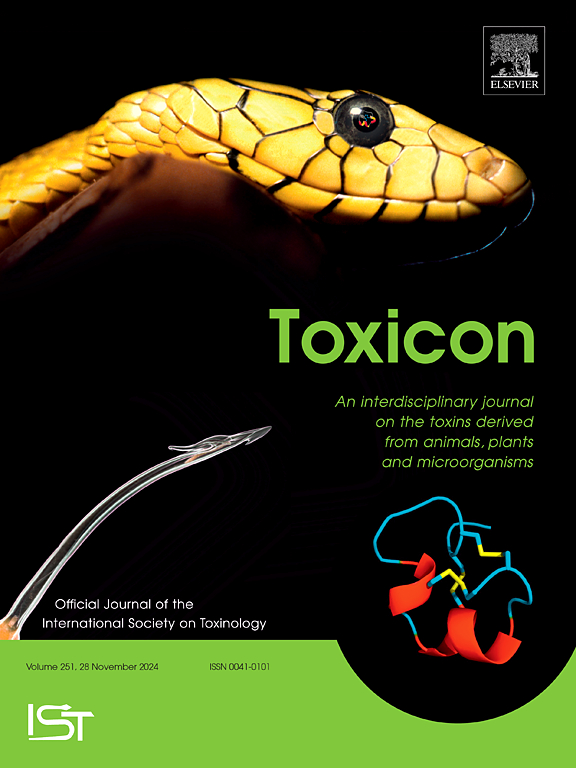基因表达和组织病理学改变揭示了珊瑚毒被低估的局部作用
IF 2.6
4区 医学
Q2 PHARMACOLOGY & PHARMACY
引用次数: 0
摘要
鱿鱼神经毒素的作用机制已被广泛研究;然而,这些毒液的病理生理作用,特别是来自珊瑚蛇的毒液,尚未得到广泛的研究。为了更深入地了解Micrurus corallinus毒液的局部和全身毒性机制及其基因组反应,我们给小鼠注射了2.70 μg的毒液,相当于亚致死剂量(LD50的50%),并使用转录组学和组织病理学方法评估了其作用。从对照组和治疗组动物的肝脏、脾脏、肾脏、心脏、大脑、膈肌和左右腓肠肌中提取mRNA,并进行RNA测序(RNA- seq),以进行差异表达基因(DEGs)的功能分析。在右腓肠肌,毒液注射的部位,我们观察到明显的组织病理学变化,其特征是明显的局部炎症反应。与这些发现一致,富集分析显示右侧腓肠肌中有2454个DEGs,主要参与炎症途径。从系统上看,肝脏是受影响最严重的非局部器官,显示出超过400个deg,其中包含几个参与急性期蛋白生产的上调基因。这些结果强调,在人类中毒过程中通常注射的亚致死量的毒液可能引起炎症,而不仅仅是神经毒性,可能是毒液的潜在有害影响,在诊断由珊瑚蛇引起的中毒时不应排除这种影响。本文章由计算机程序翻译,如有差异,请以英文原文为准。

The underestimated local effects of Micrurus corallinus venom revealed by gene expression and histopathological alterations
The mechanisms of action of elapid neurotoxins have been widely studied; however, the pathophysiological effects of these venoms, particularly from coral snakes, have not been extensively investigated. To gain a deeper understanding of the mechanisms involved in the local and systemic toxicity of Micrurus corallinus venom and their genomic responses, we injected mice with 2.70 μg of venom, corresponding to a sub-lethal dose (50 % of the LD50), and evaluated the effects using transcriptomic and histopathological approaches. mRNA was extracted from the liver, spleen, kidney, heart, brain, diaphragm, and both right and left gastrocnemius muscles of control and treated animals and subjected to RNA sequencing (RNA-Seq) to perform functional analyses of differentially expressed genes (DEGs). In the right gastrocnemius, the site of venom injection, we observed significant histopathological changes characterized by a pronounced local inflammatory response. Consistent with these findings, enrichment analyses revealed 2454 DEGs in the right gastrocnemius, mostly involved in inflammatory pathways. Systemically, the liver emerged as the most affected non-local organ, showing over 400 DEGs containing several up-regulated genes involved in the production of acute phase proteins. These results underscore that inflammation possibly induced by the sub-lethal amounts of venom typically injected during human envenomation, and not only the neurotoxicity, could be a potentially deleterious effect of venom and should not be ruled out when diagnosing envenomation caused by coral snakes.
求助全文
通过发布文献求助,成功后即可免费获取论文全文。
去求助
来源期刊

Toxicon
医学-毒理学
CiteScore
4.80
自引率
10.70%
发文量
358
审稿时长
68 days
期刊介绍:
Toxicon has an open access mirror Toxicon: X, sharing the same aims and scope, editorial team, submission system and rigorous peer review. An introductory offer Toxicon: X - full waiver of the Open Access fee.
Toxicon''s "aims and scope" are to publish:
-articles containing the results of original research on problems related to toxins derived from animals, plants and microorganisms
-papers on novel findings related to the chemical, pharmacological, toxicological, and immunological properties of natural toxins
-molecular biological studies of toxins and other genes from poisonous and venomous organisms that advance understanding of the role or function of toxins
-clinical observations on poisoning and envenoming where a new therapeutic principle has been proposed or a decidedly superior clinical result has been obtained.
-material on the use of toxins as tools in studying biological processes and material on subjects related to venom and antivenom problems.
-articles on the translational application of toxins, for example as drugs and insecticides
-epidemiological studies on envenoming or poisoning, so long as they highlight a previously unrecognised medical problem or provide insight into the prevention or medical treatment of envenoming or poisoning. Retrospective surveys of hospital records, especially those lacking species identification, will not be considered for publication. Properly designed prospective community-based surveys are strongly encouraged.
-articles describing well-known activities of venoms, such as antibacterial, anticancer, and analgesic activities of arachnid venoms, without any attempt to define the mechanism of action or purify the active component, will not be considered for publication in Toxicon.
-review articles on problems related to toxinology.
To encourage the exchange of ideas, sections of the journal may be devoted to Short Communications, Letters to the Editor and activities of the affiliated societies.
 求助内容:
求助内容: 应助结果提醒方式:
应助结果提醒方式:


